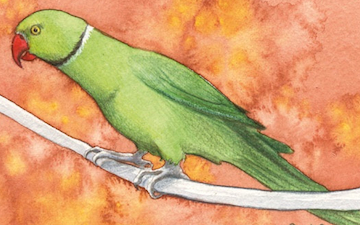The Rose-ringed Parakeet (Psittacula krameri), also known as the Ring-necked Parakeet, is a gregarious tropical Afro-Asian parakeet species that has an extremely large range. Since the trend of the population appears to be increasing, the species was evaluated as Least Concern by IUCN in 2012.[1]
Rose-ringed parakeets are popular as pets. Its scientific name commemorates the Austrian naturalist Wilhelm Heinrich Kramer.[2]
This non-migrating species is one of few parrot species that have successfully adapted to living in ‘disturbed habitats’, and in that way withstood the onslaught of urbanisation and deforestation. In the wild, this is a noisy species with an unmistakable squawking call.
Rose-ringed parakeets measure on average 40 cm (16 in) in length including the tail feathers. Their average single wing length is about 15–17.5 cm (5.9–6.9 in). The tail accounts for a large portion of their total length.
The Rose-ringed parakeet is sexually dimorphic. The adult male sports a red neck-ring and the hen and immature birds of both sexes either show no neck rings, or display shadow-like pale to dark grey neck rings
Four subspecies are recognized, though they do not differ much:
- African subspecies:
- African Ringnecked Parakeet (P. k. krameri): West Africa in Guinea, Senegal and southern Mauritania, east to Western Uganda and Southern Sudan.
- Abyssinian Ringnecked Parakeet (P. k. parvirostris): Northwest Somalia, west across northern Ethiopia toSennar district, Sudan.
- Asian subspecies:
- Indian Ringnecked Parakeet (P. k. manillensis) originates from the southern Indian Subcontinent and has feral and naturalized populations worldwide. In Australia, Great Britain (mainly around London), the United States, and other western countries, it is often referred to as the Indian Ringnecked Parrot.
- Boreal Ringnecked Parakeet, Neumann’s Ringnecked Parakeet (P. k. borealis) is distributed in Bangladesh, Pakistan, northern India and Nepal to central Burma; introduced populations are found worldwide.
A phylogenetic analysis using DNA (see Psittacula) showed that the Mauritius Parakeet (Psittacula echo) is closely related to this species, and probably needs to be placed between the African and Asian subspecies. Consequently, this species is paraphyletic.
Both males and females have the ability to mimic human speech. First it listens to its surroundings, and then it copies the voice of the human speaker. Some people hand-raise Rose-ringed parakeet chicks for this purpose. Such parrots then become quite tame and receptive to learning. They can also show emotions similar to human beings and adjust easily to family life. They take time to mimic.[citation needed]
(From Wikipedia, September 2013)





